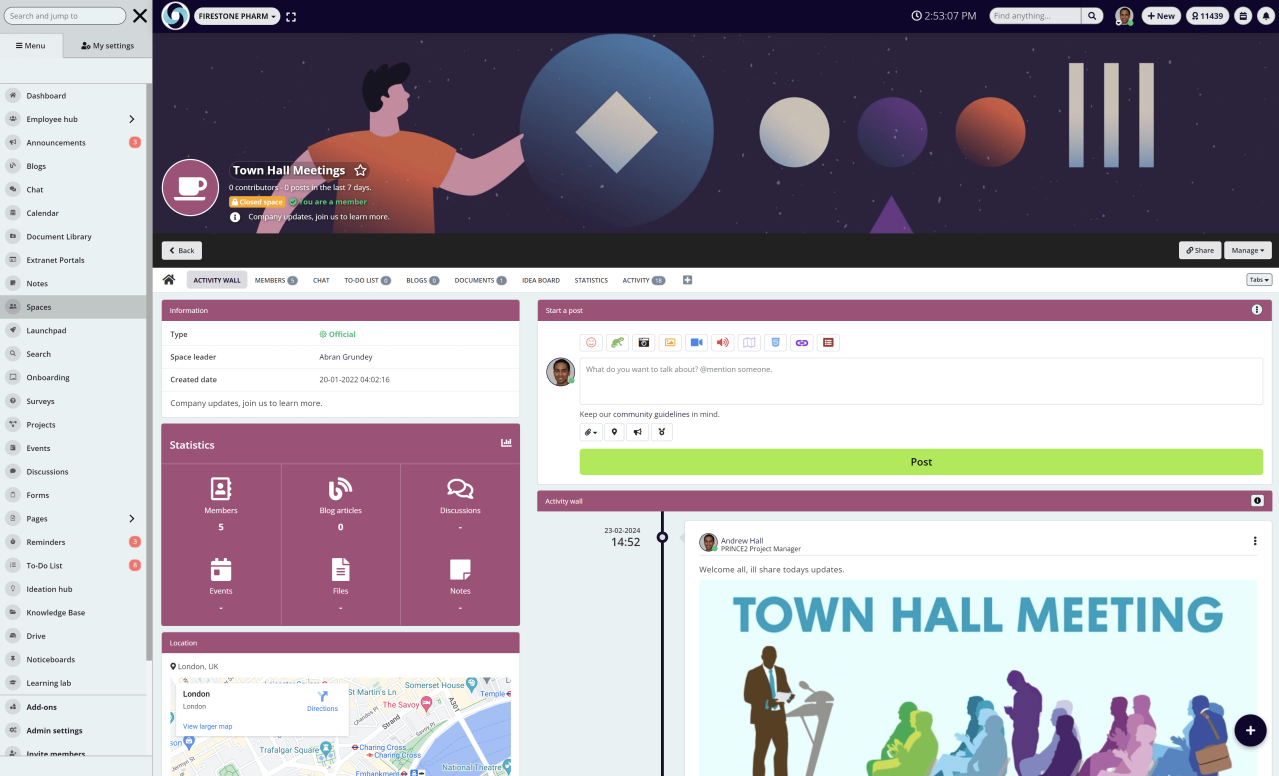Insight Blog
Agility’s perspectives on transforming the employee's experience throughout remote transformation using connected enterprise tools.
17 minutes reading time
(3384 words)
What Is A Town Hall Meeting: How to Conducting Effective Town Hall Meetings
This article explains what is a town hall meeting, the steps required to set it up and the benefits of organising one for your business.
Question today What Is A Town Hall Meeting? well it serves as a vital platform for employees to gain deeper insights into the company's mission and objectives.
Beyond being an avenue for disseminating information, it offers employees the opportunity to voice their opinions on operational matters. Additionally, these gatherings serve as a conduit for management to reinforce the company's values and effectively communicate key messages to the entire workforce.
Typically referred to as all hands meetings, town hall gatherings are orchestrated in spacious venues, accommodating the entire employee base. While the CEO usually takes center stage to address the assembly, other senior executives may also share their perspectives. The agenda often encompasses presentations from various departments, showcasing the expertise of individuals like the head of marketing or sales. This diversity of insights fosters a comprehensive understanding of the company's functioning among the workforce.
Typically referred to as all hands meetings, town hall gatherings are orchestrated in spacious venues, accommodating the entire employee base. While the CEO usually takes center stage to address the assembly, other senior executives may also share their perspectives. The agenda often encompasses presentations from various departments, showcasing the expertise of individuals like the head of marketing or sales. This diversity of insights fosters a comprehensive understanding of the company's functioning among the workforce.
Town hall meetings can be adapted to the unique needs of a company. In smaller organizations, they might manifest as casual lunches with team members or informal get-togethers. Conversely, larger corporations may opt for more formalized events, featuring presentations and interactive discussions led by top-level managers or executives.
Regardless of the format, the essence lies in creating an open forum that nurtures transparency, engagement, and a sense of collective purpose within the company.
In this blog article, we explore the concept of What Is A Town Hall Meeting and delve into the effective ways of conducting them. The focus is on understanding what a town hall meeting entails and providing insights into the best practices for ensuring their efficiency. The article aims to guide readers on the principles and methods involved in organizing and executing successful town hall meetings.
From defining the essence of a town hall meeting to offering practical tips on conducting them with effectiveness, this piece serves as a valuable resource for individuals seeking to enhance their skills in managing and participating in these communal gatherings.
Town hall meeting examples?
Town hall meetings are versatile forums that can cover various topics and address diverse concerns within an organization.
Here are a few examples of town hall meetings and their respective purposes:
- Company Updates and Strategy Discussion: Purpose: Share important updates about the company's performance, future goals, and strategic direction. Agenda: Overview of financial performance, upcoming projects, and long-term strategies. Q&A session for employees to seek clarification.
- Introduction of New Leadership: Purpose: Introduce new executives or leaders to the organization and allow employees to connect with them. Agenda: Brief biographies of new leaders, their vision for the company, and an interactive session for employees to ask questions.
- Employee Recognition and Awards: Purpose: Acknowledge and celebrate the accomplishments of employees, teams, or departments.Agenda: Presentation of awards, recognition of outstanding achievements, and expressions of gratitude. Open floor for employees to share success stories.
- Diversity and Inclusion Town Hall: Purpose: Discuss diversity and inclusion initiatives, address concerns, and promote an inclusive workplace culture. Agenda: Presentation on diversity programs, inclusion efforts, and steps taken to create an equitable environment. Open discussion on diversity-related topics.
- Wellness and Benefits Overview: Purpose: Inform employees about wellness programs, benefits, and initiatives to support their health and well-being. Agenda: Presentation on available benefits, upcoming wellness events, and resources for maintaining a healthy work-life balance. Q&A for employees seeking more information.
- Project Kickoff and Updates: Purpose: Launch a new project or provide updates on ongoing initiatives to keep the team informed and aligned. Agenda: Overview of the project, goals, milestones, and progress updates. Opportunities for team members to provide input and ask questions.
- Town Hall on Remote Work Policies: Purpose: Discuss and clarify policies related to remote work, especially in a hybrid work environment. Agenda: Presentation on remote work policies, technology support, and expectations. Q&A session to address concerns and gather feedback.
- Town Hall for Organizational Changes: Purpose: Communicate changes in organizational structure, leadership, or processes. Agenda: Explanation of the changes, reasons behind them, and how they will impact employees. Open forum for employees to share their thoughts and concerns.
These examples illustrate the versatility of town hall meetings in addressing a wide range of topics, fostering transparency, and promoting open communication within an organization.
Why do businesses have Town hall meetings?
Town hall meetings are a common practice in businesses, serving as a crucial communication platform that fosters transparency and open dialogue between leadership and employees.
One primary purpose of these meetings is to disseminate important information about the company's performance, goals, and strategic initiatives. By bringing everyone together, leadership can ensure that the entire workforce receives consistent and accurate information, aligning employees with the organization's vision and objectives. This transparency helps build trust and a sense of belonging among employees, as they feel included in the decision-making processes that shape the company's direction.
So, town hall meetings provide an opportunity for employees to ask questions, seek clarification, and express their concerns directly to leadership. This two-way communication is essential for maintaining a healthy and engaged workforce. It allows employees to feel heard and valued, promoting a sense of ownership in the organization's success.
So, addressing queries and concerns in a public forum helps dispel rumors and ensures that everyone has a clear understanding of the company's current state and future plans.
Another crucial aspect of town hall meetings is the promotion of a unified corporate culture. These gatherings provide a platform for recognizing and celebrating achievements, milestones, and outstanding employee contributions. By publicly acknowledging and appreciating the efforts of individuals or teams, town hall meetings contribute to a positive work environment and motivate employees to continue striving for excellence.
So in a nutshell, town hall meetings play a vital role in shaping a company's culture, fostering communication, and building a cohesive and informed workforce.
What is the difference between All-hands versus town hall meeting?
The terms "all-hands meeting" and "town hall meeting" are often used interchangeably, but there are subtle differences in their connotations and usage within the business context.
An "all-hands meeting" typically refers to a gathering that involves the entire workforce of a company, regardless of their hierarchical level or department. The primary goal is to bring together every employee, providing a platform for leadership to share important information, updates, and strategic initiatives directly with the entire organization. All-hands meetings focus on fostering a sense of unity and inclusivity, ensuring that everyone, from entry-level employees to top executives, is present and engaged.
On the other hand, a "town hall meeting" is a broader term that can extend beyond the corporate setting. While it is commonly used in business, it can also be applied in various contexts, such as politics or community organizations. In a business context, a town hall meeting typically involves employees gathering to discuss various topics, ask questions, and provide feedback to leadership.
The format is often more interactive, allowing for a two-way communication flow between employees and management. Town hall meetings may also feature presentations from different departments and encourage open dialogue on a range of issues.
So in summary, while both terms generally refer to large gatherings involving the entire workforce, the distinction lies in the emphasis and context. "All-hands meeting" emphasizes inclusivity and unity within the organization, while "town hall meeting" carries a broader connotation, suggesting a more interactive and open forum for discussion and feedback.
What is the format of a town hall meeting?
The format of a town hall meeting can vary depending on the organization, its objectives, and the specific topics to be addressed. However, a typical town hall meeting often follows a structured format to ensure effective communication and engagement. Here's a general outline:
Opening Remarks:
- Welcome and introduction by the facilitator or moderator.
- Overview of the purpose and agenda for the town hall meeting.
Leadership Address:
- Presentation or address by senior leadership, often by the CEO or other executives.
- Sharing key updates, strategic initiatives, or important information with the entire workforce.
Departmental Presentations:
- Representatives from different departments may give brief presentations on their recent activities, achievements, or upcoming projects.
- This provides a well-rounded view of the organization's functions and contributions from various teams.
Q&A Session:
- Open floor for employees to ask questions or share concerns.
- Questions may be submitted in advance or taken live during the meeting.
- Responses provided by leadership or subject matter experts.
Employee Recognition:
- Acknowledgment of employee achievements or milestones.
- Recognizing outstanding performance or contributions.
Interactive Activities:
- Engaging activities to promote team-building, collaboration, or feedback.
- This could include polls, surveys, or small group discussions.
Closing Remarks:
- Summary of key points discussed during the meeting.
- Expression of gratitude for employee participation and contributions.
- Information about future town hall meetings or avenues for ongoing communication.
Follow-Up:
- Communication about how questions or concerns raised during the meeting will be addressed.
- Distribution of meeting highlights or key takeaways.
- Encouragement for ongoing feedback and communication.
It's important to note that the format can be adapted based on the organization's culture, size, and specific goals for the town hall meeting. The key is to create an environment that encourages open communication, engagement, and collaboration among employees and leadership.
Follow us and access great exclusive content everyday: Follow us on Google News
5 Reasons why town hall meetings are important
- Community Engagement and Participation: Town hall meetings provide a platform for community members to actively engage in local governance and express their opinions. This fosters a sense of involvement and empowerment among residents, encouraging them to actively participate in shaping the future of their town or community.
- Transparent Governance: Holding town hall meetings promotes transparency in governance. It allows local leaders to communicate directly with constituents, sharing information about current policies, upcoming projects, and addressing concerns. This open communication helps build trust between the community and their elected representatives.
- Problem Solving and Decision Making: Town hall meetings serve as a forum for identifying and addressing community issues. Residents can voice their concerns, and local leaders can gather valuable feedback. This exchange of ideas aids in collaborative problem-solving and assists decision-makers in making informed choices that align with the needs and preferences of the community.
- Social Cohesion: Regular town hall meetings contribute to the development of a strong sense of community. By bringing people together, residents can better understand each other's perspectives, fostering a more cohesive and supportive social environment.
- Educating the Public: Town hall meetings provide an opportunity to educate the public on various issues, policies, and initiatives. This helps community members stay informed and enables them to make well-informed decisions about local matters.
- Accountability of Leaders: The public forum of town hall meetings ensures that elected officials and leaders are held accountable for their actions and decisions. Citizens can directly question leaders about their policies and decisions, promoting accountability and responsiveness in local governance.
- Accessibility and Inclusivity: Town hall meetings create an accessible space for all members of the community to participate, regardless of socio-economic status or background. This inclusivity ensures that diverse voices are heard and considered in the decision-making process.
- Promoting Civic Responsibility: By actively participating in town hall meetings, individuals develop a sense of civic responsibility. This involvement in local governance encourages a broader understanding of democracy and fosters a culture where citizens take an active role in shaping their community.
These reasons collectively highlight the multifaceted importance of town hall meetings in promoting democracy, community engagement, and effective local governance
Key Questions for a Town Hall Meeting
In the dynamic landscape of today's corporate world, town hall meetings serve as crucial platforms for communication between leadership and employees.
Anticipating and effectively addressing questions during these sessions is paramount for fostering transparency and trust.
Whether you find yourself in the role of a CEO seeking to navigate challenging inquiries or an employee eager for insights on engaging with leadership, the following common questions often emerge during town hall meetings.
- Executives may face inquiries about new initiatives within the organization and the potential impact on the workforce. Employees are keen to understand the strategic direction the company is taking and how these changes will shape the future. Providing a comprehensive overview of these initiatives, along with the associated benefits and challenges, can help align the entire team towards common objectives.
- Another key area of interest is upcoming changes within specific departments. Employees want to know about impending shifts, restructurings, or expansions and the measures being taken to prepare the workforce. Offering insights into the rationale behind these changes and the support mechanisms in place demonstrates a commitment to transparency and employee well-being.
- Employee benefits and perks often spark curiosity during town hall meetings. Whether it's health benefits, professional development opportunities, or other workplace incentives, employees seek clarity on the value proposition offered by the organization. Leaders should be prepared to articulate the company's commitment to employee well-being and growth.
- The evolving nature of workstyles, especially in the era of remote and hybrid work, is a pertinent topic. Employees may inquire about the company's stance on these arrangements and how it plans to accommodate diverse working preferences. Clear communication on policies and initiatives related to remote work fosters a sense of inclusivity and adaptability within the workforce.
- Company values play a crucial role in shaping the organizational culture. Employees may seek to understand how these values are actively applied in day-to-day operations. Leaders should highlight examples of how the company's core principles guide decision-making, collaboration, and overall workplace behavior.
- Changes in management can also raise questions during town hall meetings. Employees may seek updates on recent shifts in leadership and the potential implications for the organization. Providing insights into the reasons behind management changes and the envisioned positive outcomes can help alleviate concerns and build confidence.
- Lastly, progress updates on recent projects showcase the organization's commitment to transparency and accountability. Addressing questions related to project milestones, challenges faced, and future plans demonstrates a proactive approach to keeping employees informed and engaged.
Town hall meetings serve as invaluable opportunities for open communication and alignment within an organization. Being well-prepared to address common questions in these forums is a strategic imperative for fostering a culture of trust, collaboration, and shared success.
You may also like: Best Apps for Employees: UPDATED 2022 – A Complete Guide
8 Ways to How to lead a town hall meeting?
Leading a town hall meeting effectively requires a combination of strong leadership, communication skills, and a genuine connection with the audience.
Here's a guide to help you navigate and lead a successful town hall meeting:
- Preparation is Key: Begin by thoroughly preparing for the town hall meeting. Understand the agenda, know your audience, and anticipate potential questions or concerns. This preparation will instill confidence in your leadership and help you respond effectively.
- Clear Communication: Communicate with clarity and simplicity. Avoid jargon and use language that everyone can understand. Clearly articulate the purpose of the meeting and the topics to be discussed. Be transparent about any challenges or changes within the organization.
- Engage the Audience: Encourage active participation from the audience. Create an open and inclusive atmosphere where individuals feel comfortable expressing their thoughts. Field questions, listen actively, and respond thoughtfully. Acknowledge diverse perspectives and foster a sense of community.
- Address Key Topics: Cover the key topics relevant to the audience, such as new initiatives, upcoming changes, and progress updates. Provide context for each topic, explaining the rationale behind decisions and actions. This ensures that everyone is on the same page and understands the direction of the organization.
- Be Authentic: Authenticity builds trust. Share your own thoughts and experiences, and be genuine in your communication. Authentic leadership fosters a connection with the audience and helps build a positive organizational culture.
- Utilize Visual Aids: Enhance your communication with visual aids, such as slides or charts, to illustrate key points. Visual elements can simplify complex information and make the content more accessible to the audience.
- Manage Time Effectively: Respect the audience's time by adhering to the schedule. Be mindful of the duration of the meeting and allocate sufficient time for questions and discussions. Efficient time management demonstrates organizational skills and reinforces professionalism.
- Follow-Up: Conclude the town hall meeting by summarizing key points and addressing any outstanding concerns. Additionally, provide avenues for further communication, such as feedback channels or follow-up sessions. This demonstrates a commitment to ongoing dialogue and collaboration.
By incorporating these strategies, you can lead a town hall meeting that engages, informs, and builds a positive and collaborative organizational culture.
How Can you hold a town hall meeting on AgilityPortal?
The utilization of AgilityPortal and video calls has become increasingly prevalent, particularly with the surge in remote working.
Incorporating these platforms into town hall meetings has become a standard practice. The logistical challenges of assembling everyone in a physical location, especially amidst the rise of remote work, have made virtual town hall meetings a practical and inclusive alternative.
AgilityPortal, coupled with video conferencing capabilities, provides a comprehensive solution for conducting town hall meetings in the virtual space. The platform's agility lies in its versatility, making it an ideal tool to foster seamless communication and engagement across diverse teams.
Here's how Agility Portal can be effectively employed for town hall meetings:
- Accessibility and Inclusivity: AgilityPortal facilitates accessibility, ensuring that all team members, regardless of their geographical location, can participate in town hall meetings. This inclusivity is crucial for organizations with dispersed teams or those embracing remote work.
- Real-time Interaction: The platform's video call feature enables real-time interaction during town hall meetings. This feature is invaluable for fostering engagement, as it allows participants to ask questions, provide feedback, and actively participate in discussions, creating an immersive and collaborative virtual experience.
- Document and Resource Sharing: AgilityPortal's capabilities extend beyond video calls to document and resource sharing. This feature is instrumental for distributing important information, such as presentation slides, project updates, and relevant documents, ensuring that all participants have access to the same information simultaneously.
- Enhanced Security and Control: Security is a paramount concern in virtual meetings, and AgilityPortal addresses this with robust security features. The platform provides control over meeting access, ensuring that only authorized individuals can participate, safeguarding sensitive organizational information.
- Recording and Playback: AgilityPortal allows town hall meetings to be recorded, offering the advantage of playback for those unable to attend in real-time. This feature enhances accessibility and ensures that all team members have the opportunity to catch up on important discussions and updates.
- Seamless Integration with Collaboration Tools: The platform seamlessly integrates with various collaboration tools, enhancing the overall efficiency of virtual town hall meetings. Integration with calendars, messaging apps, and project management tools streamlines communication and coordination before, during, and after the meeting.
- Analytics and Feedback Mechanisms: AgilityPortal provides analytics on meeting engagement and attendance, offering valuable insights into the effectiveness of town hall meetings. Additionally, feedback mechanisms allow participants to share their thoughts, contributing to continuous improvement in virtual communication strategies.
In conclusion, the integration of AgilityPortal for town hall meetings aligns with the evolving dynamics of remote work and distributed teams.
Its features not only address the logistical challenges posed by physical gatherings but also enhance the overall effectiveness, inclusivity, and engagement levels of virtual town hall meetings. Embracing these technological solutions ensures that organizations can navigate the changing landscape of work with agility and resilience.
Free ebook: How To Get Your Intranet Off The Ground
Wrapping up
Furthermore, the interactive nature of town hall meetings fosters a sense of community and connection among employees.
Beyond being a platform for information dissemination, these gatherings provide a forum for open dialogue and constructive feedback. By actively involving employees in discussions, companies not only demonstrate a commitment to transparency but also empower their workforce to contribute ideas and perspectives.
This participatory approach contributes to a positive work culture, where employees feel valued, acknowledged, and an integral part of the decision-making process. Ultimately, the reciprocal communication established in town hall meetings contributes to a more engaged, motivated, and satisfied workforce.
Categories
Blog
(2664)
Business Management
(326)
Employee Engagement
(213)
Digital Transformation
(178)
Growth
(122)
Intranets
(120)
Remote Work
(61)
Sales
(48)
Collaboration
(39)
Culture
(29)
Project management
(29)
Customer Experience
(26)
Knowledge Management
(21)
Leadership
(20)
Comparisons
(7)
News
(1)
Ready to learn more? 👍
One platform to optimize, manage and track all of your teams. Your new digital workplace is a click away. 🚀
Free for 14 days, no credit card required.
















